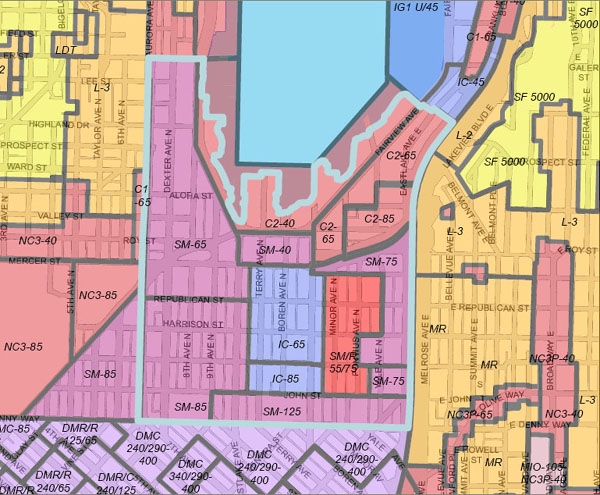SLU is Jonesin to Get High
The City has recently embarked on a year-long process to do what so obviously needs to be done in South Lake Union: upzone. Last December, keeping Amazon in town was deemed important enough to ram through the upzone of two blocks for 160-foot buildings. But for a neighborhood-wide rezone, a full-blown Environmental Impact Statement (EIS) is required.

As the zoning map above shows, allowed building heights drop precipitously once you move north across Denny Way and enter SLU (border in light blue). With the exception of the narrow strip of SM-125 along Denny, the allowed heights in SLU are roughly comparable to Seattle urban villages such Ballard.
But SLU is not your typical Seattle urban village. It’s on downtown’s doorstep. It’s hemmed in by Seattle’s two major north-south roadways, on the east by I-5, and on the west by Highway 99. It’s highly urbanized and packed with commercial and industrial uses, but has relatively little residential (though that’s been increasing in recent years). To the north it borders some low-rise residential zones, but it doesn’t come close to any of our sacred single-family zones.
Furthermore, SLU is in a valley, lessening the impact that tall buildings have on the viewsheds from surrounding areas. And let’s not forget that we just paid for a new streetcar through the neighborhood that needs lots more density to justify its existence.
There is no other neighborhood outside of downtown where upzoning is such a no-brainer. That is not to say these changes would have no downside: Change is impossible without disruption. Lack of affordable housing and loss of commerical and industrial uses are the two main risks. But given the current state of the world, this risk doesn’t justify halting densification. Our challenge is to find a way to increase density while preserving what we value.
So far the City has held an urban form charette, during which a set of development scenarios (big pdf) were defined in order to provide a basis for the EIS. The image below illustrates the “Parks Focus” option, wherein the densest development is clustered around Lake Union Park and Denny Park. Building forms have been simplified to three typologies: 65–85′ “breadloafs,” 125–160′ “wedding cakes,” and 240–400′ towers. Note that with no upzone, we would end up with a district of breadloafs, similar in massing to the Alley 24 buildings across the street from REI.
It is certain that the task of determining the optimum zoning arrangement will be both complex and controversial. But let’s not be timid, as in, why not upzone the whole damn thing up to 400 feet? Cause Planet Earth is jonesin for a fix of smarter urban development.

